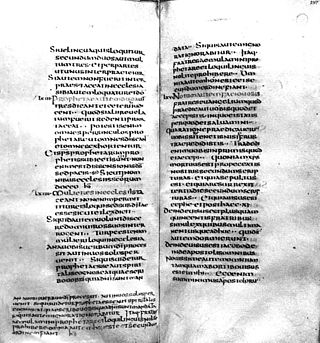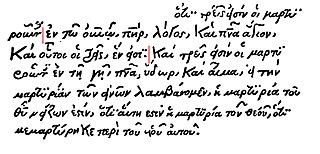
The Johannine Comma is an interpolated phrase (comma) in verses 5:7–8 of the First Epistle of John.

The Irish Gospels of St. Gall or Codex Sangallensis 51 is an 8th-century Insular Gospel Book, written either in Ireland or by Irish monks in the Abbey of St. Gall in Switzerland, where it is now in the Abbey library of St. Gallen as MS 51. It has 134 folios. Amongst its eleven illustrated pages are a Crucifixion, a Last Judgement, a Chi Rho monogram page, a carpet page, and Evangelist portraits.

The Codex Fuldensis, also known as the Victor Codex, designated by F, is a New Testament manuscript based on the Latin Vulgate made between 541 and 546. The codex is considered the second most important witness to the Vulgate text; and is also the oldest complete manuscript witness to the order of the Diatessaron. It is an important witness in any discussion about the authenticity of 1 Corinthians 14:34–35 and the Comma Johanneum. It is one of the earliest dated manuscripts of the New Testament. It was corrected until 2 May, 546 AD.

Codex Sangallensis, designated by Δ or 037, ε76, is a Greek-Latin diglot uncial manuscript of the four Gospels. Using the study of comparative writing styles (palaeography), it is usually dated to the 9th century CE, though a few palaeographers would place it in the 10th century CE. It was given its current name by biblical scholar Johann Martin Augustin Scholz in 1830.

Codex Montfortianus designated by 61, δ 603, and known as Minuscule 61 is a Greek minuscule manuscript of the New Testament on paper. Erasmus named it Codex Britannicus. Its completion is dated on the basis of its textual affinities to no earlier than the second decade of the 16th century, though a 15th-century date is possible on palaeographic grounds. The manuscript is famous for including a unique version of the Comma Johanneum. It has marginalia.
Codex Regis, is a Greek minuscule manuscript of the New Testament, on parchment leaves. Palaeographically it has been assigned to the 12th-century. It has marginalia.
Minuscule 177, α 106 (Soden), is a Greek minuscule manuscript of the New Testament, on parchment. Palaeographically it has been assigned to the 11th century. Formerly it was labelled by 179a, 128p, and 82r. It has marginalia.
Minuscule 206, α 365 (Soden), is a Greek minuscule manuscript of the New Testament, partly on parchment, partly on paper. Palaeographically it has been assigned to the 15th century.
Minuscule 209, δ 457 and α 1581 (Soden), is a Greek minuscule manuscript of the New Testament, on parchment. Paleographically it has been assigned to the 14th century, with an exception to the Book of Revelation which was added to the codex in the 15th century. It has marginalia.
Minuscule 221, α69 (Soden), is a Greek minuscule manuscript of the New Testament, on parchment. Paleographically it has been assigned to the 10th century. Scrivener labelled it by 212a and 250p. It has marginalia.

Minuscule 223, α 263, is a Greek minuscule manuscript of the New Testament, on parchment. Palaeographically it has been assigned to the 14th-century. Formerly it was labeled by 223a and 277p. Scrivener labelled it by 220a and 264p.
Minuscule 429, α 398, is a Greek minuscule manuscript of the New Testament, on cotton paper. Palaeographically it has been assigned to the 14th century.
Minuscule 465, α 166, is a Greek minuscule manuscript of the New Testament, on parchment. Palaeographically it has been assigned to the 11th century. The manuscript has complex contents. Formerly it was labeled by 114a and 134p. It has liturgical books.
The Codex Complutensis I, designated by C, is a 10th-century codex of the Christian Bible. It is written on vellum with Latin text mainly following the Vulgate. Parts of the Old Testament present an Old Latin version.
Minuscule 629, α 460, is a Latin–Greek diglot minuscule manuscript of the New Testament, on parchment. It is known as Codex Ottobonianus. Palaeographically it has been assigned to the 14th century. The manuscript is lacunose. It is known for the Comma Johanneum.
Minuscule 636, α 598, is a Greek minuscule manuscript of the New Testament, on paper. Palaeographically it has been assigned to the 15th century. The manuscript has complex contents. Formerly it was labeled by 174a and 212p.
Minuscule 918, O 66, is a 16th-century Greek minuscule manuscript of the New Testament on paper, with a commentary. The manuscript is famous for the Comma Johanneum.

The Codex Toletanus, designated by T, also called Biblia hispalense or Seville Bible, is a 10th-century Latin manuscript of the Old and New Testament. The text, written on vellum, is a version of the Latin Vulgate Bible, which contains the entire Bible, including the trinity reference Comma Johanneum.

The Codex Sangallensis 907, designated S, is an 8th-century Latin manuscript of the New Testament. The text, written on vellum, is a version of the Latin Vulgate Bible. It contains the text of the Catholic epistles, Book of Revelation, and non-biblical material. The manuscript did not survived in a complete condition and some parts of it has been lost. The codex contains the Comma Johanneum.

The Codex Sangallensis 381 is an early medieval music manuscript, produced in the abbey of St. Gallen and stored in the Abbey Library in St. Gallen. The manuscript is known for its exhaustive collection of so-called tropes, verses, and sequences. Together with the Cod. Sang. 484, this manuscript makes an important contribution to one of the most exhaustive collections of such compositions in the East Frankish kingdom and thus plays an important role in the history of music.
![Codex Sangallensis 63 with the Comma Johanneum added later in a different hand and in darker ink at the bottom left:
...tre[s] sunt pat[er] & uerbu[m] & sps [=spiritus] scs [=sanctus] & tres unum sunt.
Translation: "three are the father and the word and the holy spirit and the three are one." Cod. Sangallensis 63 (277).jpg](http://upload.wikimedia.org/wikipedia/commons/thumb/3/39/Cod._Sangallensis_63_%28277%29.jpg/260px-Cod._Sangallensis_63_%28277%29.jpg)








